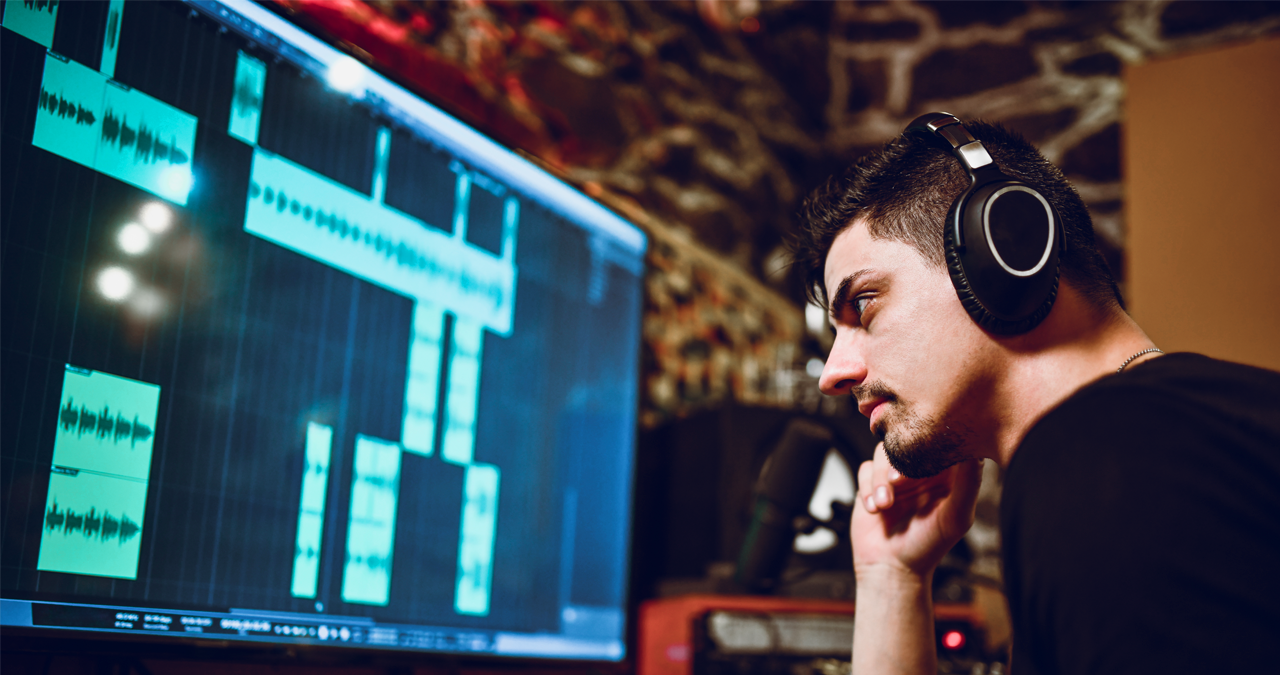Reference tracks can be your secret weapon when mixing - but be mindful of replicating other artists' creative decisions
Comparing your mix to another can nudge you into a safe technical zone, but remember to maintain your originality

In the last instalment of this ongoing music-making advice series we extolled the virtues of listening to a broad array of music with your emotional radar switched on. Feeling how music actually works to affect us can inform our songwriting and creative process, but when it comes to the granular makeup of mixing, a sharper focus on the fine details is needed.
So, switching off our emotional radar for now, we're going to look a little at deploying reference tracks when building out a mix arrangement in your DAW.
This approach to learning from other people’s music can directly inform how our track's mix is shaped from both a structural and dramatic point of view as well as from a volume and technical standpoint.
But it's really vital to remember something that often gets missed in more prescriptive guides to A/B'ing with reference tracks. And that is to make sure that our ideas aren't swamped by the human urge to compare and rate what we're doing against 'better', finished productions.
If we notice any sizeable technical deficiencies between our track and our reference - and there likely will be some - then don't be disheartened.
We can learn from that difference.
Lesson #4: Using reference tracks when writing or mixing can provide a useful template for developing a release-ready track. But beware of falling into the trap of rigid replication
On a practical level, then, there's different things we should be looking for when working with reference tracks.
Fundamentally we're investigating how another artist/producer has built their song, and how they've gone about carving each technical element (frequency balance, instrumental spread, musical information, tempo etc) to emphasise the emotion - or energy - of their track.
But before we can learn from said tracks, just how do we get our hands on, and properly import, a reference track?
Firstly, you need to establish the genre (or closest-related genre), BPM and instrumental breadth of your own track, as well as any specific mix issues that you're struggling with.
Want to learn more about how sub frequencies work? Or perhaps you're trying to figure out how and when to bring in a counter-melody. Jot it down - it's better to have clear objectives of what to look out for.
Want all the hottest music and gear news, reviews, deals, features and more, direct to your inbox? Sign up here.
With this information, think about tracks (or artists) that might have influenced your music-making. If you can't think of anything comparable to the type of track you're making, then you can locate and preview similar-sounding tracks via tagged music catalogues like those on Bandcamp or Beatport.

Working with reference tracks
1: The first thing you’ll need is the reference track as a lossless stereo file. You should locate a WAV or FLAC-formatted file if you can. Try to avoid lossy formats like MP3.
You can use your preferred streaming platform, and route the audio of your computer output into your DAW but, for our purposes we want to put an actual audio file into our DAW to help us map out the arrangement.
Stores like Bandcamp, HDTracks and Beatport allow you to download audio files in various formats if you don’t have any locally.
2: With the reference track’s audio file now downloaded, open a new instance of your DAW and drag in the audio file onto a track. Make sure there's no default effects or routings going into this audio track. Now, listen.
As you listen, you can start to map out the arrangement of your reference using your DAW’s built-in arrangement markers, such as Logic’s Arrangement Track.
3: With the structure of the track's arrangement logged, we can also inspect the raw audio and its loudness levels during various parts of its arrangement. We can open our own mix in a separate window and compare and contrast.
4. While it's often preferable to house this reference in a new project so you can chart its arrangement, you might want to place your reference track within your own mix’s project file for instant A/B comparison. You could simply include it as a muted audio track which you call up, periodically, to stack against your own mix.
Really though, for more detailed analysis we recommend you get your hands on a comprehensive mix reference plugin such as ADPTR Audio’s Metric AB or iZotope Ozone’s in-built A/B feature. Both of which are excellent choices for time-saving and for giving meticulous technical feedback instantly with the track loaded into the same project.

That’s the how covered, now why should you do this? Just how can you practically apply this listening process?
A big reason that people use reference tracks is to get a cap on final volume levels (particularly when mastering) but also to directly compare track-specific information like tempo, frequency balance and the spread/depth of instruments within the mix. If your own mix is plagued with phase issues or muddy frequency ranges, then working out how the pros have spaced out their tracks can help you to unpick your problems.
Then there's also that overall 'feel' of a track that is achieved by the numerous elements working in tandem that is harder to breakdown, yet listening in contrast to your own work, can be a good indicator of whether more power is needed to accentuate your hooks.
Other aspects to consider when using reference tracks include:
- The energy and momentum of a track's beats and rhythm - how they grow and shrink at various moments through the track.
- The frequency balance of various instruments, and how certain components relate and interact with each other
- Providing insight into how artists/producers actually use instruments to emphasise their hooks and counter-melodies. Sometimes, they might just be using subtle instrumentation or sound design to wring out emotion from certain arrangement sections.
- The frequency of melodies and hooks, and how they might re-appear in various forms throughout the track.

Some of the best ways to zoom in on the fine details include
1: Using an EQ (or low pass filter) you can notch everything down except the low-end information (everything sub 250 Hz-ish) then gradually rise the ducked frequencies into the mid-range. Make a note of where in the frequency spectrum the other elements start to become prominent. Compare with your own track - are your core elements in a similar position?
2: Monitor overall volume levels of the reference track and compare with your own. Betweeen -14 and -16 LUFS (Loudness Units Full Scale) is industry-recommended, but might not necessarily be appropriate for your track. Use a loudness/LUFS meter such as the free Youlean Loudness Meter or Mastering the Mix’s Levels to see where you're at. If you're way off this standard, you'll probably want to reign it in (or crank it up!) a little.
3: Level-match specific sections of your reference to your own mix to see, for example, whether your chorus lifts the energy of your track to the same extent as the reference track's does. Remember to jot down time-stamped notes as to what’s going on (‘unexpected synth stab’ - ‘unnerving guitar line’ etc).
4: Depending on the track itself, you might even want to call up a stem splitter (now handily integrated into many DAWs) to extract specific musical information and see what each part is doing in isolation.
5: Try to recreate the arrangement of the reference mix in a new project - switching out chords (or adding extensions/inversions to the same chords) and try to match the intensity levels and balance of each element as a pure exercise in mixing.
At the end of your reference track analysis, you should be able to have a clearer handle of the types of sound, energy and frequency levels that your developing mix needs.
But, as we stated at the outset, don't feel like you need to firmly match every single component from the reference track 100%. In fact, definitely don't try to do this.
Music-making - and even the more technical mix stage - is ultimately an art, and therefore rigid imitation will lead to a mix that sounds committee-designed.
Reference tracks can be extremely useful for pushing you onto the right track when it comes to corralling your mix elements and figuring out if your track is working in the way that you want it to - but they aren’t a blueprint to tightly imitate.
If, say, one of your mix elements has been recorded too hot and is clipping its channel, or has begun unexpectedly clashing with another instrument, but, to your ear, the result oddly sounds like the coolest thing ever - then keep it as it is.
Your ears and creative judgement take precedence over the orthodox of mix engineering. But knowing where the boundaries are gives you a better awareness of how to break them.

I'm Andy, the Music-Making Ed here at MusicRadar. My work explores both the inner-workings of how music is made, and frequently digs into the history and development of popular music.
Previously the editor of Computer Music, my career has included editing MusicTech magazine and website and writing about music-making and listening for titles such as NME, Classic Pop, Audio Media International, Guitar.com and Uncut.
When I'm not writing about music, I'm making it. I release tracks under the name ALP.
You must confirm your public display name before commenting
Please logout and then login again, you will then be prompted to enter your display name.